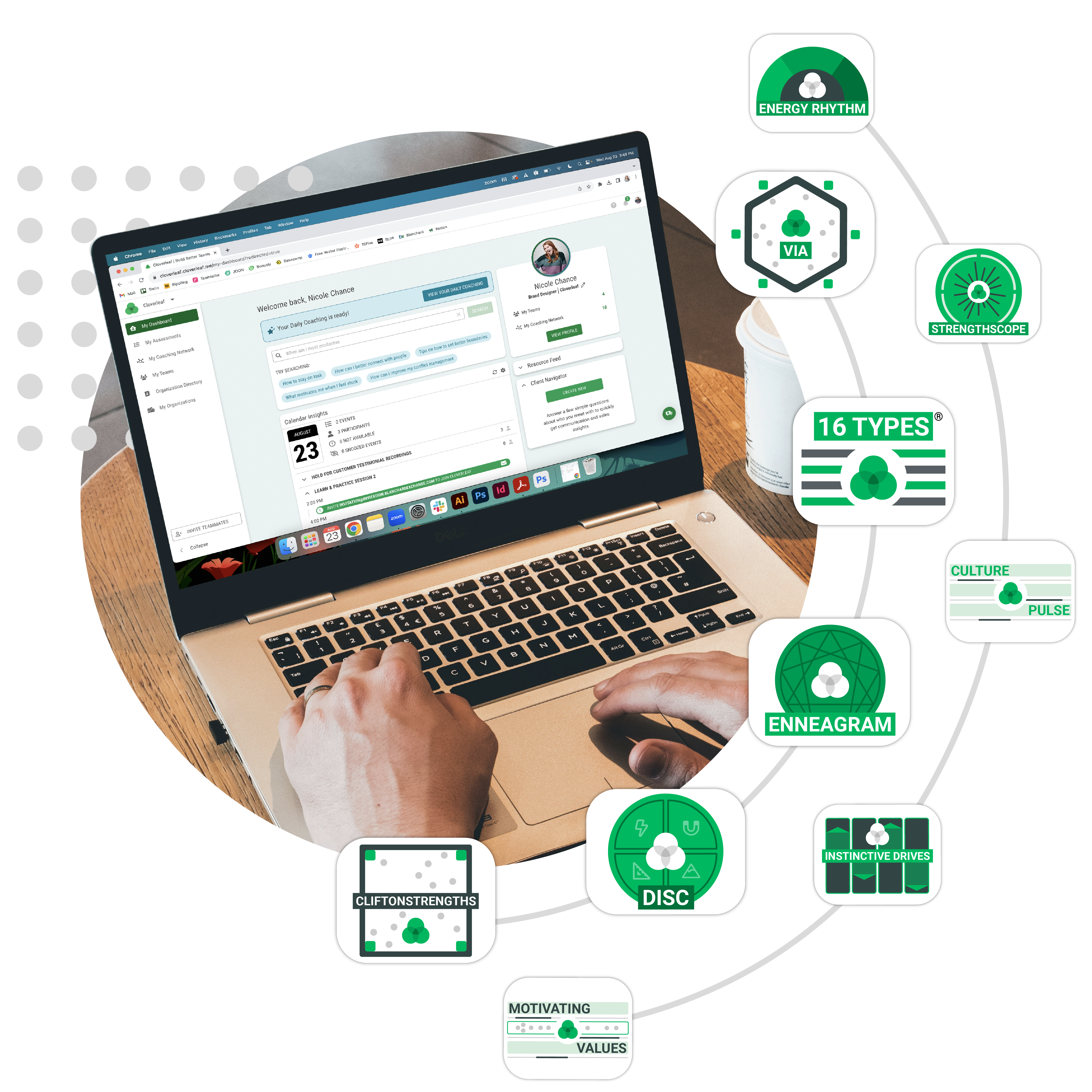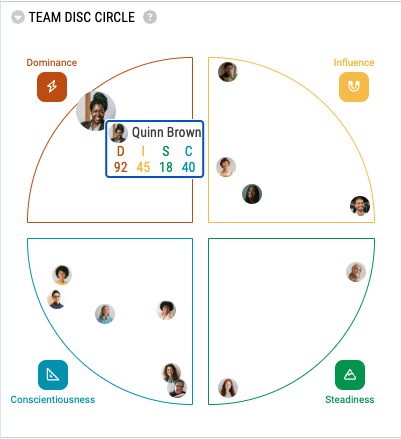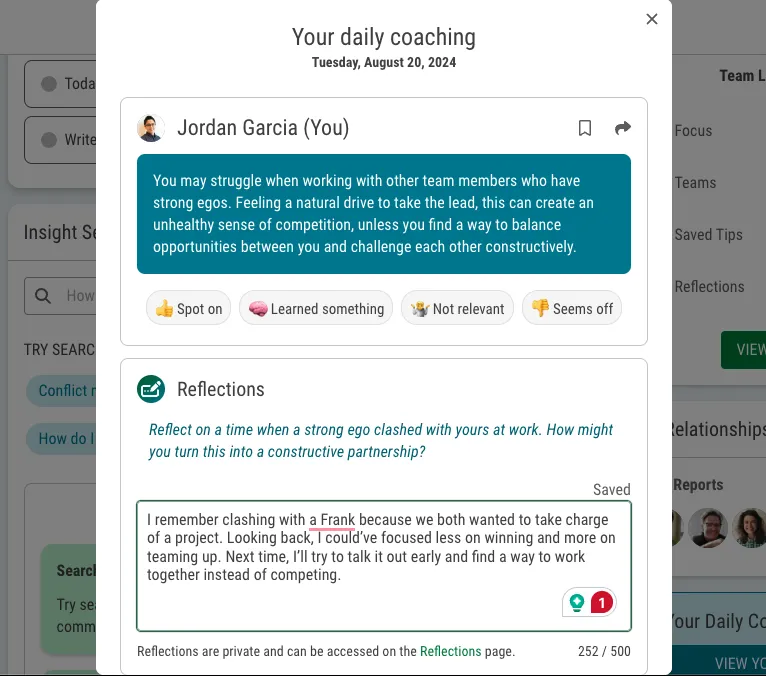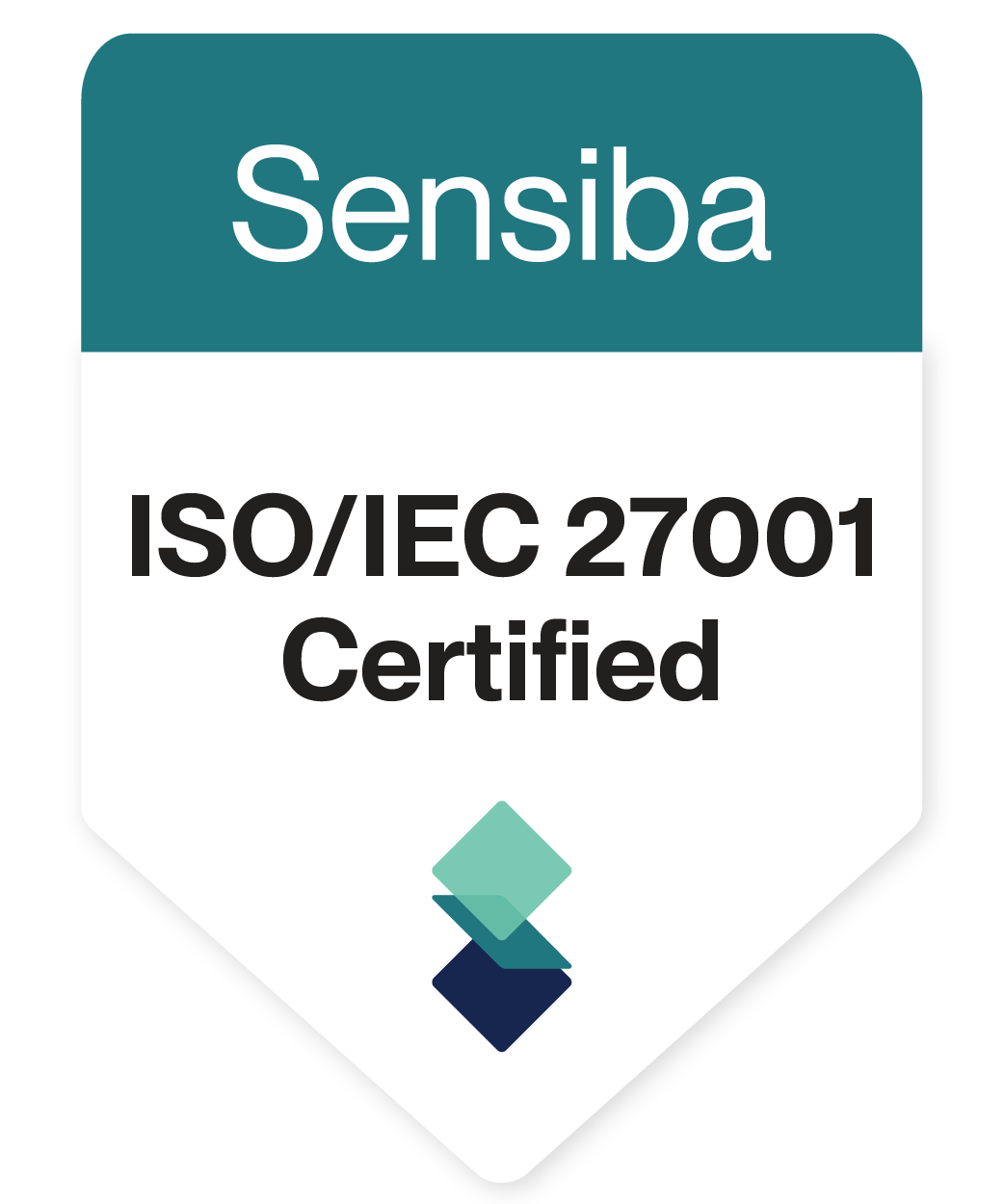Conflict is one of the biggest drains on workplace performance—yet most managers aren’t trained to handle it effectively.
📌 Civility Index Score: 46.1, with 65% of workers saying managers prioritize business goals over respectful treatment (SHRM).
📌 46% of managers are expected to provide more constructive feedback, but only 28% feel HR has adequately trained them to do so (Lattice State of People Strategy Report).
📌 Organizations that invest in leadership development to improve conflict resolution training—see an 11% increase in profitability (Gallup).
Despite the clear impact on engagement, productivity, and retention, conflict resolution is rarely treated as a core leadership competency. Instead of providing structured training, most organizations expect managers to navigate difficult conversations on their own—leading to avoidance, frustration, and unnecessary turnover.
Why This Approach Is Costing Companies More Than They Realize
Organizations that take a proactive approach to equip managers with conflict resolution skills and real-time coaching—see measurable business results:
✅ Stronger team performance: Conflict becomes a source of innovation, not dysfunction.
✅ Higher retention: Employees feel heard, valued, and supported in resolving challenges.
✅ Faster decision-making: Issues are addressed productively rather than festering.
This article will explore why conflict resolution training for managers is challenging to implement, how to make conflict resolution a leadership strength, and the best strategies to help managers confidently handle tough situations.
Get the full guide to Talent Development in the Age of AI to empower your managers to navigate tough conversations with confidence.
The Heavy Costs of Poor Conflict Management
Workplace conflict isn’t just uncomfortable—it’s expensive. When tensions go unresolved, they erode trust, stall productivity, and increase turnover. Yet, many organizations fail to equip managers with the tools they need to navigate difficult conversations effectively.
📌 73% of HR leaders say their employees are experiencing change fatigue. Additionally, 74% agree that managers are not adequately equipped to lead change, further complicating transformation efforts (Gartner).
📌 91% of high-performing HR teams meet most or all of their managers’ needs—highlighting the impact of HR’s role in leadership support (Lattice).
📌 68% of employees say learning and development (L&D) initiatives are essential for engagement, but many organizations underinvest in developing the human skills managers need to improve conflict resolution (Lattice).
Without training training that can reinforce key insights concerning conflict resolution, managers often default to avoidance or reactive decision-making—both of which make problems worse. Instead of feeling confident to coach employees through disagreements, they sidestep difficult conversations or escalate issues to HR, leading to frustration, disengagement, and lost productivity.
Why Managers Struggle With Conflict Resolution
Most managers don’t avoid conflict because they don’t care—they avoid it because they don’t feel equipped to handle it well. Common challenges include:
✅ Lack of training – Many managers are promoted for their technical skills, not their ability to navigate interpersonal challenges.
✅ Fear of damaging relationships – Without guidance, managers worry that addressing conflict will harm team dynamics rather than improve them.
✅ No reinforcement in daily work – Even when managers receive training, it’s often a one-time event rather than an ongoing skill-building process that is relevant to their context and the people they lead.
Organizations that invest in integrating conflict resolution training into leadership development see stronger teams, better decision-making, and higher engagement. The key is empowering leaders to develop conflict management as a core leadership skill.
7 Conflict Management Skills Every Manager Needs to Master
Conflict isn’t a problem to eliminate—it’s a reality to navigate. And how managers handle it directly impacts team culture, productivity, and retention.
Yet, most managers aren’t trained in conflict resolution. Many either avoid tough conversations or address issues reactively, only stepping in when tensions reach a breaking point.
Conflict resolution is a skill that can be learned, developed, and applied in everyday leadership. Here are seven essential skills managers need to turn workplace friction into productive dialogue and stronger collaboration.
Most conflicts aren’t really about the problem itself—they’re about how people feel about the problem. And nothing fuels frustration faster than feeling unheard.
1. Active Listening: Understand Before You Respond
Effective managers don’t just hear what’s being said—they engage, clarify, and ensure understanding by:
✅ Paraphrasing what they hear to ensure understanding.
✅ Asking clarifying questions to uncover deeper concerns.
✅ Acknowledging emotions before jumping into solutions.
💡 Conflict-Savvy Leadership: Before jumping into problem-solving, focus on validating the other person’s perspective. Reflect back what you’re hearing to confirm understanding and reduce defensiveness.
For example: Instead of immediately offering solutions, try saying, It sounds like you’re frustrated because ____. Am I understanding that correctly? This small shift helps build trust and encourages a more open, productive conversation.
2. Self-Awareness: Recognize Your Own Conflict Patterns
Managers can’t guide teams through conflict if they don’t understand how they personally react to tension. Do they avoid difficult conversations? Do they become overly direct? Do they default to appeasing others?
Self-awareness is the foundation of effective conflict resolution. Managers should:
✅ Identify their own natural conflict style (e.g., avoidant, competitive, collaborative).
✅ Recognize when emotions are driving their reactions.
✅ Learn how their personality impacts how they give and receive feedback.
💡 Conflict-Savvy Leadership: Managers who know they tend to avoid conflict can challenge themselves to lean into tough conversations earlier, preventing minor issues from escalating into bigger problems.
3. Emotional Regulation: Stay Grounded in the Moment
When tensions rise, so do emotions. But great managers don’t just control their tempers—they recognize emotions as information and respond thoughtfully.
Emotional agility means:
✅ Pausing before reacting to avoid escalating the situation.
✅ Separating emotions from facts to stay objective.
✅ Coaching employees through their own emotional responses.
💡 Conflict-Savvy Leadership: When a team member gets defensive during feedback, a skilled manager doesn’t force the conversation forward—they recognize the tension and reset the tone. Try saying, I can tell this is frustrating. Let’s take a step back—what’s your biggest concern? This simple shift can lower defensiveness and open the door for a more productive discussion.
4. Conflict Style Adaptability: Adjust Your Approach to the Situation
Not everyone handles conflict the same way. Some people are direct and assertive, while others prefer a more diplomatic, consensus-driven approach. The best managers adjust their approach based on the situation and the individuals involved.
Managers should try to:
✅ Recognize different conflict styles (e.g., avoidant, competitive, accommodating, collaborative).
✅ Adapt communication to match the preferences of their team members.
✅ Encourage self-awareness so employees understand their own conflict tendencies.
💡 Conflict-Savvy Leadership: Effective managers tailor their feedback approach based on individual communication styles. A highly direct employee may respond best to a straightforward, concise approach, while others may benefit from more context and encouragement. Recognizing these differences strengthens trust and ensures feedback is both constructive and well-received.
5. Framing Conversations Productively
How managers frame a conflict can determine whether it leads to resolution or resistance.
Instead of dwelling on the problem, effective managers reframe conflicts as shared challenges to solve together.
✅ Use neutral language to avoid triggering defensiveness.
✅ Frame disagreements as shared goals rather than opposing viewpoints.
✅ Shift from blame to solutions—what’s next, rather than what went wrong?
💡 Conflict-Savvy Leadership: Rather than solely focusing on differences, a skilled manager can bring together opposite parties by highlighting shared goals: It’s clear you both want this project to succeed—let’s find a way to leverage both perspectives. This reframing shifts the focus from opposition to collaboration, making resolution more productive.
6. Addressing Tension Early Instead of Waiting for a Major Issue
Most workplace conflicts don’t start as major issues—they build up over time.
Managers who address small tensions early can prevent full-scale breakdowns in communication and collaboration.
✅ Notice small signs of conflict before they escalate (e.g., passive-aggressive emails, changes in body language).
✅ Coach team members in the moment instead of waiting for formal interventions.
✅ Encourage real-time feedback to resolve tensions quickly.
💡 Conflict-Savvy Leadership: Small tensions, if ignored, can snowball into deeper issues. Proactive managers don’t wait for formal reviews—they step in early with curiosity and care.
For example: If two team members seem at odds in meetings, a quick check-in like, I’ve noticed some friction in discussions lately. What’s your perspective on what’s happening? opens the door for resolution before conflict escalates.
7. Creating a Culture Where It’s Safe to Disagree
Conflict isn’t inherently bad—but when employees fear retaliation, rejection, or judgment, they won’t speak up, leading to resentment and disengagement.
Managers set the tone for psychological safety by:
✅ Encouraging open, honest dialogue without fear of punishment.
✅ Leading with curiosity instead of defensiveness during disagreements.
✅ Modeling vulnerability—admitting when they’re wrong or need to learn.
💡 Conflict-Savvy Leadership: A culture of open dialogue starts with how managers handle disagreement. When employees feel safe to challenge ideas without fear, innovation and trust thrive.
For example: If a manager notices hesitation in meetings, they can reframe the space for input by asking, I want to make sure we’re considering all perspectives. What’s a concern or alternate viewpoint we haven’t explored yet? This small shift signals that differing opinions are not just tolerated—they’re valued.
Conflict Can Strengthen Teams—If Managed Well
Conflict isn’t a roadblock—it’s a turning point. How a manager responds determines whether it becomes a source of tension or a catalyst for growth.
Leaders who build these seven conflict management skills can create a culture where challenges spark innovation, where tough conversations build trust, and where disagreements lead to stronger, more aligned teams.
Conflict is inevitable—but dysfunction doesn’t have to be. With the right approach, managers can turn everyday friction into momentum for their teams and organizations.
How To Empower Managers To Develop Conflict Resolution Skills In 2025
Most organizations expect managers to handle conflict well—but they struggle to equip them to do it effectively. Most conflict resolution training does not lead to behavior change because it’s event-based, overly theoretical, and isolated from real team dynamics.
Conflict resolution isn’t a script to memorize—it’s a skill that must be practiced, refined, and reinforced in real moments. To truly empower managers, conflict resolution development must:
1. Embed in Daily Work, Not Treated as a Separate Initiative
- Conflict management isn’t an abstract leadership theory—it’s a daily reality. Yet, most training happens in a vacuum, disconnected from actual workplace interactions.
- Managers need reinforcing nudges to apply what they learn—before, during, and after difficult conversations.
- Conflict resolution skills should be developed just like any other leadership skill—through repetition, reflection, and reinforcement in real situations.
💡 From Theory to Practice: Ungate training that teaches conflict management by using technology to support managers with insightful guidance when they need it most—before a tough conversation, after a miscommunication, or during a team disagreement.
2. Strengthen Collective Development, Not Just Individual Training
- Conflict resolution isn’t just a manager’s responsibility—it’s a team skill.
- When teams develop conflict skills together, they:
✅ Build a shared language for resolving tensions.
✅ Learn to navigate disagreements productively instead of avoiding them.
✅ Reduce reliance on managers as the sole problem-solvers. - Leaders don’t need to have all the answers—they need to create an environment where healthy conflict is normal and productive.
💡 From Theory to Practice: Instead of putting the full burden on managers, create opportunities for teams to practice conflict resolution together. Empower your people with tools that make collaboration and open dialogue stronger every day.
3. Personalize to Individual Strengths and Team Context
- One size fits many leadership training often doesn’t work because every manager and team operates differently.
- Effective conflict resolution training should be adapted to a leader’s natural style, their team’s unique communication norms, and the specific conflict they encounter most often.
- Confidence is key—many managers know conflict resolution techniques but hesitate to use them. Development should focus not just on skills but also on building confidence to navigate tough conversations.
💡 From Theory to Practice: Provide managers with learning and development tailored to their personality, leadership style, and real challenges—so they can handle conflict in a way that plays to their strengths.
Most managers want to handle conflict well. To truly empower them, organizations need to:
✅ Make conflict resolution a daily practice, not a one-time event.
✅ Create team-wide accountability for managing conflict, not just put it on managers.
✅ Ensure training is personalized, practical, and confidence-building.
This approach will help managers move from conflict avoidance to conflict mastery—ultimately leading to stronger teams, healthier work cultures, and more effective leadership.
What If You Could Get Along With THAT CoWorker? Take A Tour Of Cloverleaf.
The Patterns Behind Workplace Conflict (And How to Break Them)
Workplace conflict isn’t random—it follows patterns. When managers understand why tensions arise, they can address conflict before it escalates.
Here are seven common conflict triggers and how managers can navigate them effectively:
1. Communication Breakdowns
Miscommunication fuels most workplace tensions. Unclear instructions, assumptions, or missed cues create unnecessary frustration and misunderstandings.
✅ What to do: Normalize clarifying questions. Instead of assuming alignment, encourage teams to double-check expectations early.
2. Unclear Expectations
Ambiguity around roles, priorities, and ownership leads to friction and finger-pointing.
✅ What to do: Set clear expectations upfront and revisit them regularly—especially when priorities shift.
3. Workload Imbalance
When some team members feel overburdened while others seem underutilized, resentment builds.
✅ What to do: Regularly check in on workload distribution and encourage transparency when people feel stretched too thin.
4. Personality & Work Style Differences
People approach work differently. Some prioritize efficiency and results, while others focus on process and collaboration. These differences can create tension if unrecognized.
✅ What to do: Help teams understand each other’s communication styles and problem-solving approaches to prevent misinterpretations.

Leverage Behavioral And Strength-Based Assessments For Greater Self-Awareness In Your Organization
Tools for assessment and personal growth can be pivotal when personality issues arise. These resources can aid individuals in recognizing their areas of expertise and areas for improvement, offering insights into varied approaches to work and communication.
5. Defensive Reactions to Feedback
When employees perceive feedback as a threat rather than a tool for growth, they may react with defensiveness or withdrawal.
✅ What to do: Frame feedback as a dialogue, not a critique. Reinforce that feedback is about shared success, not personal judgment.
6. Inconsistent or Changing Processes
Frequent changes to policies, procedures, or leadership priorities can cause frustration and confusion.
✅ What to do: Be transparent about why changes are happening, and give teams space to express concerns.
7. Past Work Experiences & Unspoken Assumptions
People bring past workplace baggage into new roles. Previous toxic work environments may cause them to assume the worst in difficult situations.
✅ What to do: Create a culture where employees feel safe voicing concerns instead of making assumptions.
💡 Takeaway: Conflict isn’t about fixing people—it’s about creating clarity, alignment, and trust. Managers who recognize these patterns can turn tension into progress.
FAQs: Common Conflict Challenges & How to Handle Them
1. How do I know when to step in vs. let my team handle conflict on their own?
✅ Step in when: The conflict is harming collaboration, causing disengagement, or becoming personal.
✅ Let them navigate when: The disagreement is respectful, and team members are working toward a solution independently.
2. What if an employee refuses to engage in conflict resolution?
✅ Acknowledge their hesitation and explore why they’re resisting.
✅ Create a low-pressure, neutral space to discuss concerns.
✅ If needed, break the conversation into smaller steps rather than forcing an immediate resolution.
3. How can I help a team member who gets defensive during feedback?
✅ Make feedback specific, objective, and tied to shared goals.
✅ Acknowledge emotions without letting them derail the conversation.
✅ Shift from blame to curiosity: What feels frustrating about this feedback?
Final Thoughts: Conflict Is an Opportunity—If Managers Are Equipped to Handle It
Most workplace conflict isn’t about bad people—it’s about misaligned expectations, miscommunication, and missed opportunities for clarity.
Too often, organizations focus on minimizing conflict—but the real opportunity is learning how to use it productively.
A team that never disagrees? That’s not collaboration—that’s avoidance.
A manager who “keeps the peace” by shutting down tough conversations? That’s not leadership—that’s short-term damage control.
High-performing teams don’t eliminate conflict. They get better at having it.
✅ They challenge ideas without damaging relationships.
✅ They resolve tensions before they derail progress.
✅ They see conflict as a signal for growth, not a sign of dysfunction.
And they have managers who create the conditions for all of this to happen.
💡 The real shift in thinking? Conflict isn’t a problem to fix—it’s a skill to master.
When managers develop this skill, they don’t just reduce workplace tension—they build teams that trust each other, tackle challenges head-on, and drive better results together.
The future of leadership isn’t conflict-free. It’s conflict-capable.
How Does Cloverleaf Help Resolve Conflict In The Workplace
Cloverleaf helps teams move beyond reactive conflict management by providing context driven insights, coaching, and data-driven guidance that empower managers to anticipate, navigate, and resolve tensions before they escalate. The result? Stronger team dynamics, healthier communication, and a workplace where differences lead to innovation—not dysfunction.

Core Conflict Management Solutions Delivered by Cloverleaf:
1. Anticipating Team Friction: Instead of reacting to conflicts, Cloverleaf enables proactive measures by helping you understand the sources of conflict for every person on your team.
2. Navigating Internal Blind Spots: When internal tensions rise, seeing the overarching issues is challenging. Cloverleaf offers an external lens, bringing clarity and solutions that might be missed from an inside viewpoint.
3. Bespoke Conflict Strategies for Unique Teams: Every team is distinct, and cookie-cutter solutions often fall short. Cloverleaf customizes its approach by merging assessment data and conflict resolution coaching, ensuring that strategies resonate with your organization’s specific needs.
4. Unearthing Deep-Rooted Conflict Triggers: Addressing surface-level issues without understanding the root causes is akin to applying a band-aid on a deep wound. Cloverleaf dives deep to unearth the real reasons behind conflicts, ensuring sustainable resolutions.
5. Skill Enhancement for Modern Managers: Beyond just resolving the current conflict, Cloverleaf’s Automated Coaching™ provides actionable insights, preparing managers for future challenges, enhancing communication, and fostering a culture of continuous learning and improvement.
6. Transforming the Narrative on Conflict: Instead of being seen as roadblocks, conflicts can be growth catalysts. Cloverleaf repositions the perception of conflict, making managers not just problem solvers but also enablers of team evolution and personal growth.
We’ve all heard the stories—a newly hired C-Suite leader, brimming with technical expertise, suddenly finds themselves losing their cool in high-stakes meetings. The table-slamming, the shouting, the profanities—it’s a pattern that repeats itself far too often in organizations.
But what if these outbursts were more than just isolated incidents?
What if they were symptoms of a deeper issue that Talent Development Leaders must address?
In a conversation, a client shared his experience with a newly hired C-Suite leader who started to lose his cool a few months into the job. He described instances just like those above. It took HR exactly two weeks after a number of employees started to report these types of interactions to let the person go.
The gaps in this leader’s human skills, turned an amazing opportunity into a humiliating failure for him. While he was technically highly proficient and had the exact experience and background the company needed, none of it could save him.
When these kinds of behaviors surface, they often stem from gaps in essential human skills like emotional intelligence and conflict management. These gaps can turn extraordinary opportunities into catastrophic failures—not just for the individual but for the entire organization. While technical proficiency and experience are critical, they cannot compensate for the lack of core human skills that are crucial for effective leadership. To address these leadership breakdowns, we must look beyond the surface and tackle the root causes head-on.
Addressing the Root Causes of Leadership Failures
While it’s easy to focus on the visible manifestations of leadership breakdowns—like the outbursts and poor behavior mentioned earlier—the real challenge lies in addressing the underlying causes. These incidents are often symptomatic of deeper issues such as unaddressed stress, inadequate emotional intelligence, and a lack of continuous development in critical human skills. For Talent Development Leaders, this is where the opportunity—and responsibility—truly lies.
Improving human skills isn’t solely about avoiding such dramatic fallouts. It’s about proactively building social and human capital within the organization, creating an environment where employees can experience meaningful personal growth that makes them not just better professionals but better leaders.
Conventional approaches to leadership development often fail to provide the ongoing support managers need to navigate today’s complex work environments. Continuous development isn’t just a best practice—it’s a necessity, given the increasing pressures on leaders.
People skills are not just a benefit but a requirement. Organizations can no longer afford to take a reactive approach. Leaders need real-time, personalized insights to manage stress, improve emotional intelligence, and maintain their composure in high-pressure situations.
For organizations, the stakes extend beyond individual incidents. The ripple effects of a leadership failure can be felt across teams, departments, and even the entire organization. By proactively equipping leaders with the tools they need to succeed—not just through traditional training but through continuous, context-specific coaching—you can build a resilient leadership culture that not only prevents failures but also supports consistent growth and development.
How To Improve Human Skills In Management: From Big Picture Vision to Ground-Level Growth

Top-Down Leadership: Aligning Strategy with Human Skills
Misalignment in leadership values and approaches is more than just a growing pain—it’s a critical risk that can derail organizational success. When leaders are not aligned on core values and competencies, it leads to inefficiencies, employee dissatisfaction, and, ultimately, missed business objectives.
Step 1: Define Core Leadership Values and Competencies
The first step is clearly defining the leadership values and competencies critical to your organization’s success. This involves identifying the key qualities and skills that every leader should embody, from the C-Suite to middle management. These values should reflect the company’s long-term goals and cultural priorities.
For example, an engineering team at a startup might have been built up by a leader who cultivated a flexible work environment and prioritized mental health. However, as the company grows, it may bring in a CTO with a different leadership style that emphasizes performance in high-pressure environments. This shift can lead to misalignment if the core values and competencies are not clearly defined from the top.
Step 2: Communicate and Align Leadership Teams
Once these values and competencies are defined, the next step is communicating them across all leadership levels. Every leader must understand and buy into these principles. Regular alignment meetings, workshops, and leadership training sessions can effectively ensure that all leaders are on the same page.
To prevent misalignment, organizations must define their desired leadership values and approaches from the top down. However, defining these values is only the first step. Continuous alignment and reinforcement are necessary to ensure these values are lived daily.
Step 3: Utilize Continuous Feedback and Coaching Tools
With core values and competencies defined and communicated, the focus shifts to continuous alignment and reinforcement. This is where tools like Automated Coaching can strengthen culture and support ongoing development. By providing leaders with real-time, personalized insights, these tools help reinforce the company’s core values and leadership competencies in every interaction, ensuring that leaders consistently model the behaviors expected of them.
Step 4: Identify Skill Gaps Using Data-Driven Insights
The next step is to identify potential skill gaps among current leaders. This process should be driven by data, leveraging tools that comprehensively analyze where leaders stand regarding the desired competencies. Cloverleaf’s platform, for instance, offers detailed assessments and continuous feedback, enabling organizations to create targeted, data-driven learning paths that address these gaps effectively.
Step 5: Implement Targeted Development Programs
Finally, after identifying the gaps, organizations should execute targeted development programs. These programs should be designed to address specific gaps and reinforce the core competencies identified earlier. Regularly reviewing progress and adjusting these programs as needed will ensure that the development is ongoing and aligned with evolving organizational needs.
Ultimately, a well-executed top-down approach to leadership development, supported by continuous alignment and personalized coaching, helps individual leaders succeed and drives the organization toward its strategic goals. By ensuring that every leader is on the same page and equipped with the necessary skills, companies can build a resilient leadership culture that is ready to navigate the complexities of today’s business environment.

Ready To Build Human Skills At Scale With Your TEam?
Find Out How To Quickly:
- Close the gap between learning and on-the-job application
- Personalize growth to individual strengths and needs
- Integrate learning so it is actually in the flow of work
- Develop human skills fast enough to solve business problems
- Prove the ROI of your development programs

Bottom-Up Leadership: Building Skills from the Ground Up
While top-down alignment is critical, developing human skills within your managers through a bottom-up approach is equally vital. This method is not an alternative but a complementary strategy that, when combined with top-down efforts, yields the best results.
Step 1: Establish a Foundation of Self-Awareness
The journey begins with self-awareness, much like constructing a sturdy building requires a strong foundation. Managers must first understand their own strengths and weaknesses, recognize their natural talents, and identify areas for growth. This self-awareness forms the basis for all personal development and leadership growth.
In a study highlighted by Harvard Business Publishing, leaders who actively engaged in self-awareness exercises, such as using the “Ladder of Inference,” significantly improved their decision-making and ability to adapt as a leader. These leaders were better equipped to manage their emotional responses and lead more effectively by consciously reflecting on their thought processes and challenging their assumptions. Organizations that integrate tools to facilitate this type of reflection are better positioned to build leaders who possess a high degree of self-awareness and can remain calm and focused in the face of adversity.
Step 2: Personalized Development Journeys
Learning becomes more fruitful when managers understand their development journey and see how building on their strengths while addressing gaps can accelerate their career growth. This recognition of the organization’s investment in its growth builds trust and loyalty as managers receive the personalized support they need to enhance their performance and increase the value they bring to the organization.
The success of the bottom-up approach relies heavily on the manager’s ability to drive their learning. Continuous support and personalized feedback are critical. The following section will cover the APS Method for leadership development as a tool to support managers in developing human skills.

The APS Method for Leadership Development
The APS Method stands for Awareness, Principles, and System and is a framework for leadership development. It is a proprietary method developed by Archova that examines human skills not just tactically but incorporates the importance of awareness to begin with, the guiding principles and values that underlie a leader’s skill set, and the systematic approach to ensure skills are incorporated into and reflected by the leader’s routines and behaviors.
1. Awareness: The Foundation of Leadership Development
Awareness is the foundation of the APS Method. It involves understanding yourself as a leader—your strengths, growth areas, natural leadership style, and how you may respond to different situations. Developing self-awareness allows you to see how your behaviors and actions influence your team. It’s about knowing what makes you tick and how your actions affect others.
However, for managers to develop strong human skills, they need to become more than just self-aware; they also need to become aware of the preferences, strengths, and styles of those they work with, such as their manager, their direct reports, and other stakeholders. This awareness allows them to engage effectively with a range of different people and personalities.
Tools like Cloverleaf’s DISC assessment can be a great starting point for managers to identify their natural tendencies and possible blind spots and learn about others. Knowing we may be relationship-driven and inspired by new ideas is one thing. Still, it’s another to realize that a key person on your team operates best with clear guidelines, solid project plans, and a high degree of independent work. This dynamic, for example, will call for the manager to engage in a different approach than the type of leadership style they might personally prefer. The ability to see the DISC profiles of an entire team is a key benefit Cloverleaf offers.

2. Principles: Guiding Leadership with Core Values
Principles are the core beliefs that guide your actions and decisions. These are the enacted values you stand by and use to navigate your leadership journey. For example, principles might include acting with integrity, assuming positive intent, and putting people before productivity.
Why It Matters: Leaders without clearly defined principles often seem reactive and can easily be swayed in their decision-making process. When leaders define their principles and communicate them to others, the team tends to see consistency and reliability, which increases trust and makes it easier for them to work effectively with their leader.
3. System: Establishing Structured Routines and Practices
System refers to the structured routines and practices you implement as a leader. It involves creating and maintaining processes that ensure effective team management, such as regular one-on-one meetings, feedback loops, and performance tracking. A solid system helps you lead your team predictably and efficiently, allowing for better outcomes and a more cohesive team environment.
How Leaders Can Use the APS Method to Help Managers Strengthen Human Skills
The APS Method provides a clear path for leaders to develop their human skills through self-awareness, strong guiding principles, and effective systems. Here’s how you can apply these concepts practically, day-to-day.
1. Applying Self-Awareness in Leadership
Developing self-awareness and awareness of others is crucial for effective leadership. Here are some practical steps:
- Conduct Regular Self-Assessments: Use tools like DISC, Enneagram, or 16 Types to understand your leadership style, strengths, and growth areas. Leveraging multiple assessments gives you a nuanced understanding of yourself and your team, allowing for more informed decision-making and personalized leadership strategies.
- Seek Feedback from Team Members: Regularly gather feedback from those you work with to gain diverse perspectives on how your leadership style impacts others. This input helps identify areas for improvement that you might not see on your own.
- Reflect on Your Responses and Behaviors: Consider how your tendencies influenced recent interactions and what adjustments you might need to make. Use tools like the Reflections feature to regularly assess how your actions and decisions align with your self-awareness insights.

2. Establishing Your Leadership Principles
Leadership principles guide your decisions and actions, ensuring consistency and integrity in your leadership style. Here’s how to define and implement these principles effectively:
- Define Your Core Leadership Values: Begin by identifying the values that are most important to your leadership. Write these values down and think about the principles that best represent them. Consider how you will demonstrate these values in your daily leadership practices—how will your team see and experience these values in action?
- Communicate These Principles to Your Team: Once you’ve defined your principles, clearly communicating them to your team is essential. This ensures that everyone understands the standards you hold yourself to and can align their expectations accordingly.
- Regularly Review and Adapt Your Principles: Leadership is dynamic, and your principles may need to evolve as you and your organization grow. Set aside time to review your leadership principles regularly to ensure they remain relevant and effective. If you find that certain principles need adjustment, be open to making those changes and communicating them to your team.
3. Developing Your Leadership System
Creating a leadership system is about establishing routines and practices that reinforce your principles and self-awareness. This system should be flexible, allowing you to adapt as you grow and as your team’s needs evolve.
Here are three simple ways to build and maintain your leadership system:
1. Establish Regular Routines and Check-Ins
- Create Consistent Check-Ins: Schedule regular one-on-one meetings with your team members. These meetings provide opportunities to discuss progress, challenges, and development goals. Consistency in these check-ins helps build trust and ensures that your team feels supported.
- Set Up Feedback Loops: Implement a structured feedback system that includes both giving and receiving feedback. This system should encourage open communication and ensure timely and constructive feedback. Regular feedback helps identify areas for improvement and fosters a continuous growth culture.
2. Monitor and Adjust Your System
- Track Performance and Progress: Implement performance-tracking mechanisms to monitor how well your leadership practices work. Use tools and metrics to assess whether your routines and practices are helping you achieve your leadership goals.
- Reflect and Adjust: Regularly reflect on the effectiveness of your leadership system. Consider whether your routines produce the desired outcomes and adjust as needed. This reflection ensures that your system evolves with your leadership journey.
3. Document Your Leadership System
- Create a Leadership Playbook: Document your leadership system, including your routines, principles, and feedback processes. This playbook serves as a reference for yourself and can be shared with others in leadership roles to ensure consistency across the organization.
- Regularly Update Your Documentation: Keep your documentation updated as your leadership practices evolve. This living document will help you stay aligned with your goals and ensure that your leadership approach remains relevant and effective.
A Strategic Path to Leadership Excellence
By focusing on the three pillars of the APS Method—Awareness, Principles, and System—leaders can adopt a proactive, reflective, and systematic approach to developing human skills. This not only leads to sustainable results and continuous improvement but also cultivates a leadership culture that thrives on growth and adaptability.
The importance of developing human skills cannot be overstated. The downfall of technically proficient yet emotionally unaware leaders highlights the need for a balanced approach that marries technical expertise with strong interpersonal skills. These skills are not merely complementary; they are essential for navigating the complexities of modern leadership.
A Dual Approach for Lasting Impact
Adopting both a top-down and bottom-up approach to building human skills enables organizations to create a cohesive leadership culture that aligns with their core values while empowering individual leaders on their personal growth journeys. This dual strategy ensures that leadership development is holistic, addressing both organizational alignment and individual capabilities.
The APS Method offers a practical, actionable framework for managers to cultivate the essential human skills that define effective leadership. By integrating self-awareness, clearly defined principles, and structured systems into daily practice, leaders can ensure that their growth is consistent and deeply embedded in their leadership style.
Moving Forward: Building a Thriving Leadership Culture
Investing in developing leadership competencies is not just a preventive measure against leadership failures; it’s a strategic move to nurture an environment where leaders and their teams can thrive. This investment pays dividends in the form of resilient, adaptable teams that are capable of driving the organization forward in an ever-changing landscape.
As you reflect on the concepts discussed, consider how you can begin to apply the APS Method within your own leadership context. Start by assessing where you currently stand regarding self-awareness, principles, and systems. Then, take concrete steps to enhance these areas, using the tools and strategies provided. The journey towards leadership excellence is continuous, but with the APS Method and tools like Automated Coaching, you have a clear path to follow.


